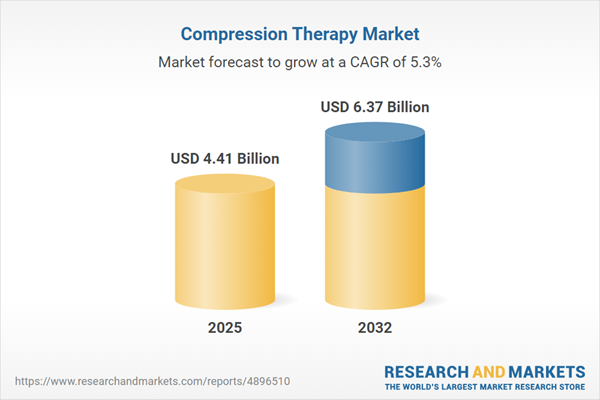Speak directly to the analyst to clarify any post sales queries you may have.
The compression therapy market is navigating pivotal change as healthcare providers embrace digital innovations and evolving patient care models, fueling ongoing transformation across global regions and clinical settings.
Market Snapshot: Navigating Growth and Innovation in Compression Therapy
The compression therapy market grew from USD 4.20 billion in 2024 to USD 4.41 billion in 2025, with projections to reach USD 6.37 billion by 2032 at a CAGR of 5.32%. This sustained momentum stems from heightened focus on noninvasive therapies, increasing demand for customizable solutions, and rising prevalence of chronic vascular conditions. Stakeholders are recalibrating strategies in response to shifts in patient demographics, care delivery models, and supply chain dynamics.
Scope & Segmentation: Compression Therapy Market Analysis
- Product Types: Compression sleeves, compression stockings (including circular knit and flat knit variants), compression wraps, elastic bandages, intermittent pneumatic devices.
- Material Types: Neoprene, rubber, textile options, each selected for specific clinical performance and user comfort attributes.
- Technology Types: Dynamic compression therapy and static compression therapy approaches designed for broad patient populations.
- Distribution Channels: Offline and online platforms driving expansion into clinics, hospitals, home care, and specialty centers.
- End User Settings: Clinic-based, hospital-based, home care, and specialty care environments.
- Applications: Deep vein thrombosis prevention, lymphedema management, post-surgical recovery, sports and orthopedic therapy, varicose veins, spider veins, venous leg ulcers.
- Regions Covered: Americas, Europe, Middle East & Africa, Asia-Pacific, with each market contributing unique regulatory, economic, and clinical dynamics.
- Key Companies Profiled: Broad spectrum of manufacturers and innovators including 3M Company, AIROS Medical, Arjo, Bio Compression Systems, Cardinal Health, ConvaTec, DJO, KOYA MEDICAL, L&R Group, medi GmbH, Medtronic, Milliken, Mölnlycke, Paul Hartmann AG, Sanyleg SRL, Sigvaris Group, Smith & Nephew, Tactile Systems Technology, Thuasne, Zimmer Biomet Holdings.
Key Takeaways: Strategic Insights for Senior Decision-Makers
- Technological advances such as integrated biosensors and wearable digital monitoring are redefining care by enabling clinicians to tailor compression protocols and enhance patient adherence.
- Personalization is scaling, notably through additive manufacturing and advanced materials, supporting individualized care for complex patient needs and anatomical diversity.
- Supply chain strategies are evolving as manufacturers diversify sourcing and adopt nearshoring in response to shifting global trade dynamics, improving resilience and operational continuity.
- Online distribution and e-commerce channels are rapidly expanding access to compression therapy, supporting direct-to-consumer models, and reducing total cost of care for providers and payers.
- Regional markets display unique drivers: Americas leverage established healthcare infrastructures, Europe emphasizes sustainability and innovation, and Asia-Pacific capitalizes on regulatory harmonization and large patient populations.
- Strategic partnerships—uniting medical device leaders with digital health innovators—are facilitating development of next-generation pneumatic systems and expanding market reach.
Tariff Impact: Supply Chain and Sourcing Adaptations
Recent changes in United States tariffs on medical device components and raw materials have influenced manufacturing costs and supply continuity. Companies are responding by broadening supplier networks and accelerating nearshoring initiatives, with ripple effects on product mix, distributor margins, and end-user preferences. These adaptive measures emphasize the necessity of agile supply chain management in an unpredictable trade context.
Methodology & Data Sources
The market insights derive from in-depth primary interviews with clinicians, distributors, and product developers across key global regions, corroborated by secondary research spanning regulatory databases, clinical trials, and industry literature. Data triangulation and segmentation analysis ensure findings accurately reflect market realities and competitive factors.
Why This Report Matters
- Enables leadership teams to optimize product portfolios and go-to-market strategies in a complex, evolving sector.
- Equips organizations to proactively manage supply chain risks and harness opportunities presented by digital health and value-based care.
- Provides in-depth coverage of segmentation, competitive intelligence, and actionable recommendations for sustainable innovation.
Conclusion
The compression therapy market is advancing through innovation, digital integration, and resilient supply chain strategies. Industry-leading organizations that prioritize patient engagement and cross-sector collaboration will be best positioned for long-term success.
Additional Product Information:
- Purchase of this report includes 1 year online access with quarterly updates.
- This report can be updated on request. Please contact our Customer Experience team using the Ask a Question widget on our website.
Table of Contents
3. Executive Summary
4. Market Overview
7. Cumulative Impact of Artificial Intelligence 2025
Companies Mentioned
The companies profiled in this Compression Therapy market report include:- 3M Company
- AIROS Medical, Inc.
- Arjo
- Bio Compression Systems, Inc.
- Cardinal Health, Inc.
- ConvaTec Group PLC
- DJO, LLC
- KOYA MEDICAL
- L&R Group
- medi GmbH & Co. KG
- Medtronic PLC
- Milliken & Company
- Mölnlycke Health Care AB
- Paul Hartmann AG
- Sanyleg SRL
- Sigvaris Group
- Smith & Nephew PLC
- Tactile Systems Technology, Inc.
- Thuasne SA
- Zimmer Biomet Holdings, Inc.
Table Information
| Report Attribute | Details |
|---|---|
| No. of Pages | 181 |
| Published | November 2025 |
| Forecast Period | 2025 - 2032 |
| Estimated Market Value ( USD | $ 4.41 Billion |
| Forecasted Market Value ( USD | $ 6.37 Billion |
| Compound Annual Growth Rate | 5.3% |
| Regions Covered | Global |
| No. of Companies Mentioned | 21 |









